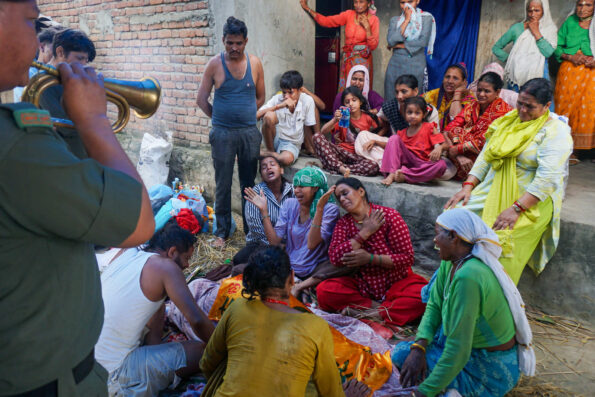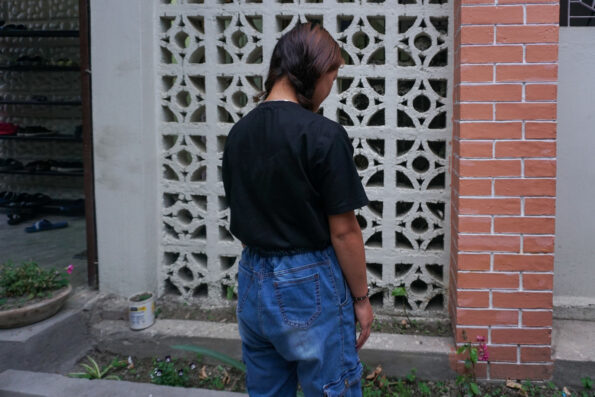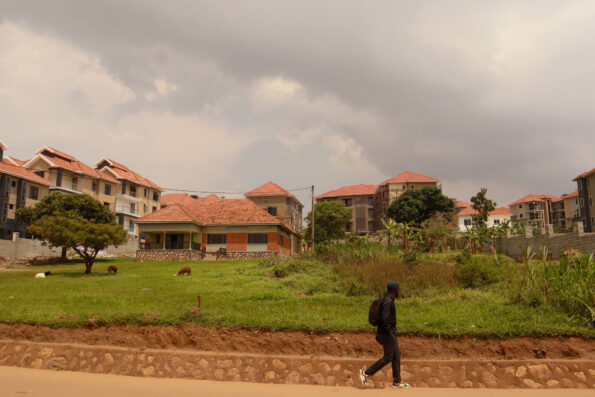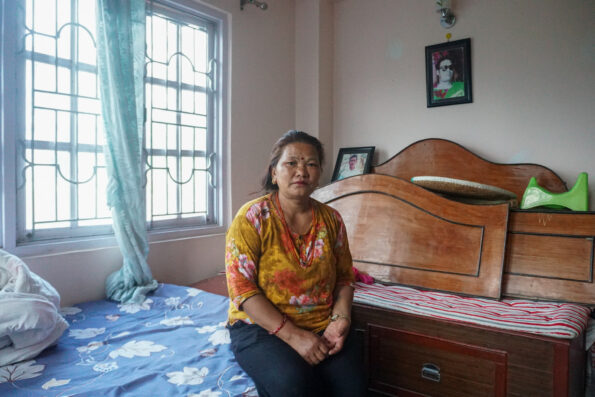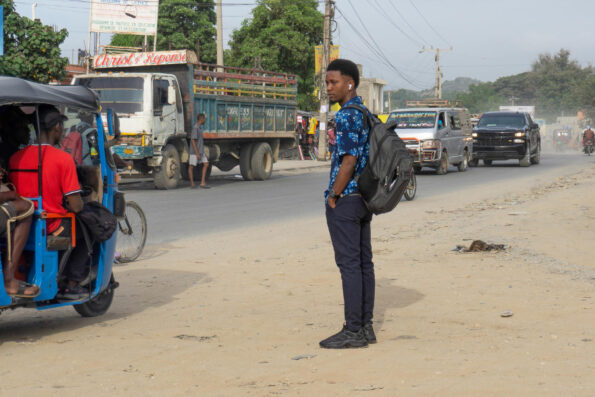
Mayamitu Neupane, GPJ Nepal
The senior center inside a refugee camp for Bhutanese people in Damak, Jhapa district, was built by the Intra-National Welfare and Support Foundation of America and serves as a meeting place for older people waiting for resettlement.
BELDANGI REFUGEE CAMP, NEPAL — His family is split across three countries. His wife, two sons and three daughters live in Bhutan. His other two sons and a daughter are resettled in the United States. And Durjodhan Gurung, 84, is here, sitting alone in Nepal’s Beldangi Refugee Camp No. 396, waiting to go back to Bhutan, his homeland.
Gurung yearns for his wife and hopes to see her and his country before he dies. But there is not much hope left among elderly refugees like him in Beldangi camp, one of the two remaining for Bhutanese refugees in Nepal. Around 1,000 of the 6,300 refugees in the two camps are either disabled, infirm or elderly, says Sanchahang Subba, secretary of the Bhutan Refugee Settlement Management Committee. Rehabilitation and resettlement in different countries have split families, forcing many older people like Gurung to live alone in the camps, with no family to take care of them.
Between 1977 and late 1980s, the Bhutan government introduced new citizenship policies targeting Lhotshampas, the Nepali-speaking people of southern Bhutan. These policies, among other things, banned the teaching of the Nepali language in schools and enforced certain majority-compliant dress codes and customs, leading to mass protests by Lhotshampas.
Gurung and his son were part of the movement against these policies. In reaction to the movement, several Lhotshampas were arrested and tortured, houses were burned down, and women were raped, according to a 2003 Human Rights Watch brief. Some Lhotshampas were expelled or denied their Bhutanese citizenship, while tens of thousands like Gurung fled the country to escape political arrest, detainment or further persecution. Many of these people settled in Nepal between 1991 and 1992, according to a 2000 report from the United Nations High Commission for Refugees.



By late 2007, a third-country resettlement program was introduced, wherein a core group of eight countries, including the United States, came together to give the refugees an opportunity to begin new lives. As many as 113,307 Bhutanese refugees were relocated to several countries as of 2019. But while most left, many still live in the two camps in Nepal, either due to their old age, documentation-related issues, criminal records, or because they want to be close to Bhutan in case they can return one day.
“Some went to realize their dreams, some went for livelihood; but seeing the condition of the elderly here, I wish there was a way to send them to their families,” Subba says. “The concerned authorities should not have broken up the family.”
Older people in the Beldangi refugee camp spoke to Global Press Journal about missing their homes and gardens in Bhutan, loneliness, being too weak to take care of themselves, and a perpetual desire to somehow go back.
The Beldangi camp
In a public square in Damak, a globe-shaped figure stands erect with two birds — including a danphe (Himalayan monal), Nepal’s national bird — perched atop it. North of this point, about 7 kilometers (4.3 miles) away, is the Beldangi camp, a settlement with a lineup of several identical bamboo huts with zinc roofing sheets.
The majority of those who live here have refugee identity cards, a legal document that grants them equal access to public education, health, banks and social protection. Subba says 700 residents don’t have these cards because they either missed the deadline to apply or had some documentation issue. The card provides a way for refugees to get a permanent account number, which then gives them license to do business inside the camp and to obtain a driver’s license, says Bishwa Raj Nepal, a spokesperson for Jhapa district. However, he says there is no data on how many have taken those steps.
Outside the entrance of the camp, there is an Armed Police Force base and a Lord Shiva temple. Schools and health facilities inside the camp closed when the majority of refugees were resettled. Those who want to study attend a public school 2 kilometers (about 1.25 miles) away. There is no regular water supply. Health checkup facilities are provided by a local hospital 1 kilometer (0.6 mile) away, but older residents find it inconvenient because they have to stand in long queues to access them. There are grocery stores, fruit stands and pharmacies near the camp’s entrance. But most older refugees who spoke with Global Press Journal say they only look at the fruit — a luxury few can afford.



Since Nepal isn’t a signatory to the 1951 Refugee Convention, a United Nations treaty that defines the rights of those fleeing their home countries, the country has hosted these refugees merely on humanitarian grounds. The United Nations World Food Programme aided refugees from Bhutan from 1992 to 2018, says Daya Krishna Dhakal, a representative of the Nepali government’s refugee coordination program. Due to “unprecedented humanitarian needs” elsewhere in the world, the donor agency first shifted its support from in-kind food assistance to cash distribution to refugees, before transitioning out of the country.
Since UNHCR and other donor agencies closed refugee facilities, it has become increasingly difficult for those living in these camps to eat two meals a day. “We have assisted the elderly in the neighborhood by providing food when they are in need, but we are refugees ourselves and cannot do so every day,” Subba says.
At the entrance of the camp, where Gurung lives, colorful prayer flags hang, but as you enter his home, it is dark. There is a bed, a chair, a stool, a stove and a few utensils that have gathered layers of dust. “I just cook rice with difficulty; my neighbors bring me some vegetables, which I eat,” he says.
The past that still haunts
Bhutan and Nepal don’t share a border; Gurung and many others came through India, in 1992. Along with his son and several others, Gurung reached Maidhar, a village on the bank of the Kankai Mai River in eastern Nepal, 25 kilometers (15.5 miles) away from the Beldangi camp.
The memory of those early days still sends shivers down Gurung’s spine, he says. Living on the bank of the Kankai, he remembers seeing 40 or 50 refugees die each day because of unhygienic conditions. He says they drank the water of the same river in which they defecated. There were so many bodies lying around that there wasn’t enough time to cremate them all, he adds.
As more Lhotshampas poured in from southern Bhutan, seven camps were created in Jhapa and Morang districts, in eastern Nepal. After six months of moving here and there, Gurung reached the Beldangi camp, where he lives now. In the camp, life became a little easier as food and other help started to arrive, he says. But that ease was also short-lived, as donor agencies stopped giving aid.
Sukamaya Rai, 71, fled to Nepal with her niece when she was 30. Her husband and three children died in Bhutan, two years apart. Her niece died of heart disease in 2022, leaving her alone at the camp. On this morning, she says it’s been 15 days since she ate a bowl of gruel with flour that her neighbor gave her. Since then, she has lived by drinking tea. “I don’t remember being happy since I came to the camp.”
At the beginning of the resettlement process, three options were put forward: return to Bhutan, remain in Nepal or resettle elsewhere. Many chose resettlement, especially after the negotiations required to provide a way back into Bhutan failed.
Those who did not resettle — continuing to count on a return to Bhutan — also kept hoping for reunification with their families. Now, many are gradually losing hope.
Manarati Gurung, 75, says being ill in a refugee camp is painful. When she gets seriously ill, she says, there is no one there to even take her to the hospital. As an elderly resident of the camp, she receives 5,000 Nepali rupees (37.50 US dollars) every third month from Intra-National Welfare and Support Foundation of America, a nongovernmental organization founded by resettled refugees. This aid covers her household expenses, but she notes, food doesn’t cook itself. INTRA also established an ashram for older residents in the camp. Between 10 a.m. and 4 p.m., they sit, talk and watch television.
After a nationwide census in Bhutan, a special census takes place in southern Bhutan in 1988. To prove their status as legal citizens, southern Bhutanese are required to produce documentation proving legal residence, such as land tax receipts from 1958 and onward. Those who cannot prove their status can apply for citizenship, provided they meet certain conditions, including 20 years of residency in Bhutan and the ability to proficiently speak, read and write in the Dzongkha language. Those who don’t meet the conditions are reclassified as illegal immigrants.
The government of Bhutan introduces several policies, including “one nation, one people,” which enforces a compulsory dress code on the Nepali-speaking Bhutanese and requires them to learn the Dzongkha language. The Nepali language is removed from school curricula.
In response, Nepali-speaking Bhutanese living in Samchi and Chirang districts, in southwest Bhutan, protest to demand civil and cultural rights for southern Bhutanese.
Widespread repression of Nepali-speaking people in southern Bhutan sees houses destroyed, men tortured and women raped. Between 80,000 and 100,000 people are forced by the government to flee Bhutan. Others leave on their own, fearing for their lives. Many board Indian trucks from the Bhutan-India border, which bring them to the Mechi Bridge at the border of Nepal and India. The refugees are dropped off on the banks of Kankai Mai River.
At the request of Nepal’s government in late 1991, the United Nations High Commission for Refugees establishes refugee camps in southeastern Nepal in early 1992. Seven different camps are set up in Jhapa and Morang districts. At the end of the exodus, about 100,000 people settle in these camps, with up to 20,000 living elsewhere in Nepal and India. The numbers are estimates, as there are many undocumented refugees beyond official records. Nepal and UNHCR jointly administer the camps, with the World Food Programme providing basic food assistance. Many other nongovernmental organizations also help. This process continues until December 2018.
The resettlement process starts and the distribution of refugee identity cards begins.
By late 2007, a third-country resettlement program is introduced. A core group of eight countries, including the United States, offers resettlement opportunities to the refugees.
Bhutan’s then-Prime Minister Jigme Thinley meets with Nepal Prime Minister Pushpa Kamal Dahal, assuring him that initiatives will be undertaken to find a solution to the refugee problem.
The number of refugees resettled in the United States and other receiving countries from camps in eastern Nepal reaches 25,000.
Under a UNHCR initiative in Nepal, refugees are provided with health insurance and mental health counseling. World Food Programme assistance ends at the close of the year.
The number of resettled refugees reaches 113,307. The seven camps are consolidated into two: Beldangi in Jhapa district and Pathari Sanischare in Morang district. By year’s end, about 6,300 refugees remain in the two camps, with about one-third expressing interest in returning to Bhutan.
As of 2024, about 1,000 of the 6,300 remaining refugees are either disabled, infirm or elderly.
The future they dread
Durjodhan Gurung has started dreading the arrival of festivals. “When my son was here, the festivals used to be fun. But now that I am alone, I wish that festivals did not come at all.” With nothing to look forward to and no one to celebrate with, he says, “festivals make you cry even more.” Regardless of age, he adds, people inside the camp don’t have any rights, and everyone has the same identifying label — that of a refugee. “We are unable to do anything because our body is old; young people are unable to do anything because their minds have made them old.”
Relatives of the refugees who live in the United States send between 5,000 and 10,000 rupees (37.50 to 75 dollars) during festivals. But apart from festivals, those living abroad say they can’t keep sending money because their lives aren’t in order either.
Subba, of the resettlement committee, says that the Nepali government should take in the remaining refugees, as there is no immediate possibility of repatriation. “If they are to be kept here, they should be given the status of Nepali citizens,” he says.
There are currently no such plans, says Dhakal, the government representative.
Durjodhan Gurung wants to return to Bhutan and die in his wife’s arms. But first, he wants to shed his refugee status. “I want to die with my identity and the Lal Purja [Nepali land ownership certificate] in my hand, and in my name.”
Mayamitu Neupane is a Global Press Journal reporter based in Nepal.
TRANSLATION NOTE
Sunil Pokhrel, GPJ, translated this article from Nepali.


